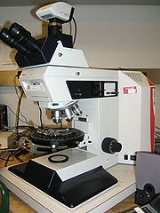
Optical mineralogy
Overview
Mineral
A mineral is a naturally occurring solid chemical substance formed through biogeochemical processes, having characteristic chemical composition, highly ordered atomic structure, and specific physical properties. By comparison, a rock is an aggregate of minerals and/or mineraloids and does not...
s and rocks
Rock (geology)
In geology, rock or stone is a naturally occurring solid aggregate of minerals and/or mineraloids.The Earth's outer solid layer, the lithosphere, is made of rock. In general rocks are of three types, namely, igneous, sedimentary, and metamorphic...
by measuring their optical
Optics
Optics is the branch of physics which involves the behavior and properties of light, including its interactions with matter and the construction of instruments that use or detect it. Optics usually describes the behavior of visible, ultraviolet, and infrared light...
properties. Most commonly, rock and mineral samples are prepared as thin section
Thin section
In optical mineralogy and petrography, a thin section is a laboratory preparation of a rock, mineral, soil, pottery, bones, or even metal sample for use with a polarizing petrographic microscope, electron microscope and electron microprobe. A thin sliver of rock is cut from the sample with a...
s or grain mounts for study in the laboratory
Laboratory
A laboratory is a facility that provides controlled conditions in which scientific research, experiments, and measurement may be performed. The title of laboratory is also used for certain other facilities where the processes or equipment used are similar to those in scientific laboratories...
with a petrographic microscope
Petrographic microscope
A petrographic microscope is a type of optical microscope used in petrology and optical mineralogy to identify rocks and minerals in thin sections. The microscope is used in optical mineralogy and petrography, a branch of petrology which focuses on detailed descriptions of rocks...
. Optical mineralogy is used to identify the mineralogical composition of geological materials in order to help reveal their origin and evolution.
Some of the properties and techniques used include:
- Refractive indexRefractive indexIn optics the refractive index or index of refraction of a substance or medium is a measure of the speed of light in that medium. It is expressed as a ratio of the speed of light in vacuum relative to that in the considered medium....
- BirefringenceBirefringenceBirefringence, or double refraction, is the decomposition of a ray of light into two rays when it passes through certain anisotropic materials, such as crystals of calcite or boron nitride. The effect was first described by the Danish scientist Rasmus Bartholin in 1669, who saw it in calcite...
- Michel-LévyAuguste Michel-LévyAuguste Michel-Lévy was a French geologist. He was born in Paris.He became inspector-general of mines, and director of the Geological Survey of France. He was distinguished for his researches on extrusive rocks, their microscopic structure and origin; and he employed the polarizing microscope...
Interference colour chartInterference colour chartAn interference colour chart, first developed by Auguste Michel-Lévy, is an optical mineralogy tool to identify minerals in thin section using a petrographic microscope. With a known thickness of the thin section, minerals have specific and predictable colours in cross-polarized light, and this... - PleochroismPleochroismPleochroism is an optical phenomenon in which a substance appears to be different colors when observed at different angles with polarized light.- Background :Anisotropic crystals will have optical properties that vary with the direction of light...
- Extinction angleExtinction angleExtinction is a term used in optical mineralogy and petrology, which describes when cross-polarized light dims, as viewed through a thin section of a mineral in a petrographic microscope. An isotropic minerals, opaque minerals, or amophous materials show no light...
- Conoscopic interference patternConoscopic interference patternA conoscopic interference pattern or interference figure is a pattern of rings caused by optical interference observed when diverging light rays travel through a non isotropic substance. It is the best way to determine if a mineral is uniaxial or biaxial and also for determining optic sign in...
(Interference figure) - Becke line testBecke line testThe Becke Line Test is a technique in optical mineralogy that helps determine the relative refractive index of two materials. It is done by lowering the stage of the petrographic microscope and observing which direction the light appears to 'move' toward. This movement will always go into the...
- Optical reliefOptical reliefOptical relief is a concept in optical mineralogy which refers to the degree in which mineral grains stand out from the mounting medium, usually either oil with a known refractive index or Canada Balsam...
- Sign of elongation (Length fast vs. length slow)
- Wave plateWave plateA wave plate or retarder is an optical device that alters the polarization state of a light wave travelling through it.- Operation :A wave plate works by shifting the phase between two perpendicular polarization components of the light wave. A typical wave plate is simply a birefringent crystal...
William Nicol, whose name is associated with the creation of the Nicol prism
Nicol prism
A Nicol prism is a type of polarizer, an optical device used to produce a polarized beam of light from an unpolarized beam. See polarized light. It was the first type of polarizing prism to be invented, in 1828 by William Nicol of Edinburgh...
, seems to have been the first to prepare thin slices of mineral substances, and his methods were applied by Henry Thronton Maire Witham (1831) to the study of plant petrifactions.
Unanswered Questions

